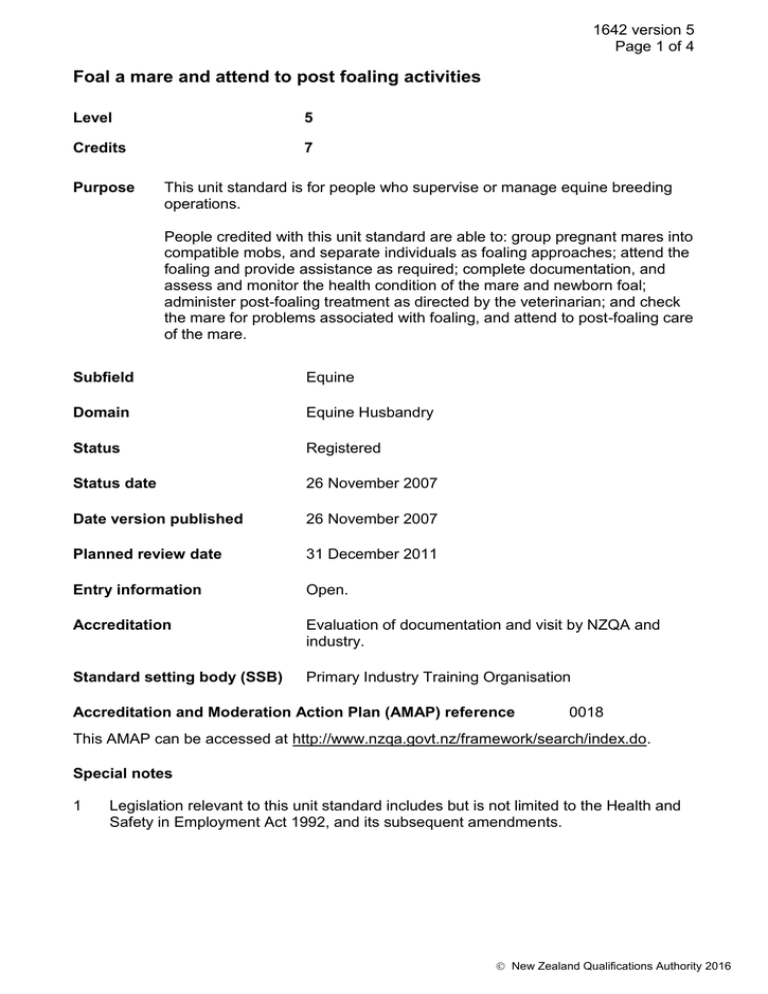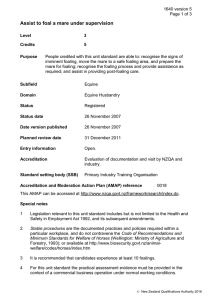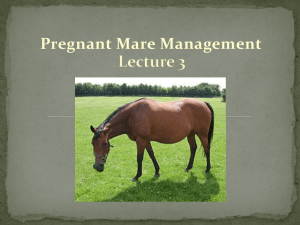Foal a mare and attend to post foaling activities
advertisement

1642 version 5 Page 1 of 4 Foal a mare and attend to post foaling activities Level 5 Credits 7 Purpose This unit standard is for people who supervise or manage equine breeding operations. People credited with this unit standard are able to: group pregnant mares into compatible mobs, and separate individuals as foaling approaches; attend the foaling and provide assistance as required; complete documentation, and assess and monitor the health condition of the mare and newborn foal; administer post-foaling treatment as directed by the veterinarian; and check the mare for problems associated with foaling, and attend to post-foaling care of the mare. Subfield Equine Domain Equine Husbandry Status Registered Status date 26 November 2007 Date version published 26 November 2007 Planned review date 31 December 2011 Entry information Open. Accreditation Evaluation of documentation and visit by NZQA and industry. Standard setting body (SSB) Primary Industry Training Organisation Accreditation and Moderation Action Plan (AMAP) reference 0018 This AMAP can be accessed at http://www.nzqa.govt.nz/framework/search/index.do. Special notes 1 Legislation relevant to this unit standard includes but is not limited to the Health and Safety in Employment Act 1992, and its subsequent amendments. New Zealand Qualifications Authority 2016 1642 version 5 Page 2 of 4 2 Stable procedures are the documented practices and polices required within a particular workplace, and do not contravene the Code of Recommendations and Minimum Standards for the Welfare of Horses. (Wellington: Ministry of Agriculture and Forestry, 1993); or available at http://www.biosecurity.govt.nz/animalwelfare/codes/horses/index.htm. 3 For this unit standard the practical assessment evidence must be provided in the context of a commercial business operation under normal working conditions. Elements and performance criteria Element 1 Group pregnant mares into compatible mobs, and separate individuals as foaling approaches. Performance criteria 1.1 Pregnant mares are placed into groups in accordance with compatibility and similar foaling dates. 1.2 An individual foaling paddock is assigned to mares showing the signs of first stage foaling in accordance with stable procedures. Range clean, fresh grass, safe, observable 24 hours per day. Element 2 Attend the foaling and provide assistance as required. Performance criteria 2.1 Documentation to record the foaling process is designed and processed in accordance to stable procedures. 2.2 Stages of labour to foaling is monitored and assessed in terms of duration and requirement of intervention according to stable procedures. 2.3 Problems occurring at each stage of foaling are outlined in terms of possible courses of action which is best for the mare. Range running colostrum, uterine inertia, oedema, colic, foal’s foot through anus, pre-mature separation of placenta, malpresentation, retained afterbirth, lack of progress. 2.4 Foetal membranes (placenta) are examined to determine complete discharge. 2.5 Veterinary assistance is sought in the event of foetal membranes (placenta) being retained beyond the normal time in accordance with stable procedures. New Zealand Qualifications Authority 2016 1642 version 5 Page 3 of 4 Element 3 Complete documentation, and assess and monitor the health condition of the mare and newborn foal. Performance criteria 3.1 Documentation for the newborn foal is completed in accordance with stable procedures. Range 3.2 Examination of the newborn foal determines health status and action taken in the event of ill health is in accordance with stable procedures and in the best interests of the foal. Range 3.3 stud purposes, Foaling Return. alert, aware, normal breathing, sight, willingness to seek and suck, teeth meet evenly, normal umbilical stump, colour of mucous membranes, limb abnormalities. Health of the mare is monitored, and action taken in the event of ill health is in accordance with stable procedures and in the best interests of the mare. Element 4 Administer post-foaling treatment as directed by the veterinarian. Performance criteria 4.1 Treatments required for the foal, and reasons for these treatments are outlined in terms of the requirements for antibiotics, enema, tetanus anti toxin, selenium, and vitamin E. 4.2 Treatments which do not require veterinary advice are administered in a manner which minimises stress to the foal and in accordance with stable procedures. Range may include but is not limited to – enema, iodine on umbilical stump. Element 5 Check mare for problems associated with foaling, and attend to post-foaling care of the mare. Performance criteria 5.1 External reproductive organs are checked for damage incurred while foaling, and action is taken in the event of obvious damage in accordance with stable procedures and in the best interests of the mare. New Zealand Qualifications Authority 2016 1642 version 5 Page 4 of 4 5.2 Washing of mare removes birth fluids and foreign matter. Range 5.3 vulva, udder, hindquarters. Teats are checked to ensure they will enable the foal to drink, and any action taken is in accordance with property procedures and in the best interests of the mare. Please note Providers must be accredited by NZQA, or an inter-institutional body with delegated authority for quality assurance, before they can report credits from assessment against unit standards or deliver courses of study leading to that assessment. Industry Training Organisations must be accredited by NZQA before they can register credits from assessment against unit standards. Accredited providers and Industry Training Organisations assessing against unit standards must engage with the moderation system that applies to those standards. Accreditation requirements and an outline of the moderation system that applies to this standard are outlined in the Accreditation and Moderation Action Plan (AMAP). The AMAP also includes useful information about special requirements for organisations wishing to develop education and training programmes, such as minimum qualifications for tutors and assessors, and special resource requirements. Comments on this unit standard Please contact the Primary Industry Training Organisation standards@primaryito.ac.nz if you wish to suggest changes to the content of this unit standard. New Zealand Qualifications Authority 2016






